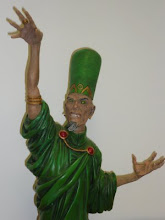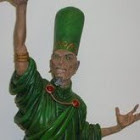 A wonderfully engaging and enjoyable comic that gives a science fiction staple an unexpected and very welcome twist. An epidemic has devastated the world population, with the remaining human settlements concentrated in Iceland and small parts of Scandinavia. Technology has not vanished, it has been diminished somewhat and a strong belief in the old gods of region has returned. 90 years after the outbreak an expedition is planned into the Silent world, where animals who have also been greatly affected by the plague live in horrifyingly changed forms, knows as trolls. A group of five explorers have been hired to venture into the Silent world to explore and report on conditions as well as to fulfill the secret reason for the expedition. The story has three parts, the first is the start of the outbreak, the second the setting up of the expedition and the third the first major encounter of the expedition with the inhabitants of the Silent world.
A wonderfully engaging and enjoyable comic that gives a science fiction staple an unexpected and very welcome twist. An epidemic has devastated the world population, with the remaining human settlements concentrated in Iceland and small parts of Scandinavia. Technology has not vanished, it has been diminished somewhat and a strong belief in the old gods of region has returned. 90 years after the outbreak an expedition is planned into the Silent world, where animals who have also been greatly affected by the plague live in horrifyingly changed forms, knows as trolls. A group of five explorers have been hired to venture into the Silent world to explore and report on conditions as well as to fulfill the secret reason for the expedition. The story has three parts, the first is the start of the outbreak, the second the setting up of the expedition and the third the first major encounter of the expedition with the inhabitants of the Silent world.Minna Sundberg has taken one of the most familiar story ideas in science fiction, a post apocalyptic world and using an expedition to explore the world and the changes that have been wreaked upon it and brilliantly changed what had always been a central element. The whole idea is inherently a gloomy idea and has a strong natural tilt to pessimism, the destruction of the physical and social framework of humanity leading to a barely contained battle for survival among those left behind. Minna Sundberg takes a different route, humanity has taken a substantial, but not fatal, beating and have found ways to accommodate this and still retain the collective will to sociability and mutual organisation that are inherent in humanity. This allows her to launch her story into an hugely engaging and unexpected direction with the focus being on the cast and how they are responding their
circumstances.
The three sections to the story mean that there is sufficient time for the the context to be established and for the cast to move naturally within it before the expedition into the very dangerous unknown takes off. The outbreak is managed with great subtlety as it captures the movements and reactions of people who are intentionally or otherwise escaping from it. They are aware to different degrees that a huge event is developing around them , there are far more concerned with their own immediate situation and circumstances. The very large cast that is involved from each of the regions that will have surviving populations are given the opportunity to be much more than symbolic versions of various strands of humanity. They are utterly and fearlessly themselves, as individual as they should be and they demonstrate Minna Sundbergs extraordinary strength as a writer. They are presented with warmth and humour without every being mocked or undermined. The most awful events and requirements for survival are presented with thoughtful care so that the second part of the story feels like a natural evolution rather than an abrupt transition. An expedition is planned and approved in a sequence that shows that humans and bureaucracy will always intersect in familiar ways. The gathering of the team is presents an opportunity, taken to the full, to introduce the cast and to nicely mix up everyone's motives and expectations. When the expedition launches the momentum of the story shifts to a greater balance between action and relationships between the team, with the action being strong and compelling and having a direct impact on the team.
The art is a pleasure to read, the cast are individual and have a thankfully wide variety of body shapes and dimensions, they look like a diverse set of humans. They move through their context with assurance, they are clearly part of the physical world , it is not just a background. The panels are used with great variety and definition to control the pace of the story, moving from widescreen to intimate with speed and never loosing the thread of the story. The colours are both eye catching and so natural that they work on all the required levels. There are strong tones for each episode which provide a clear emotional key for the events, within the dominant tone the shades are used with subtlety to draw out the details which give the panels depth and weight. The extremely difficult problem of drawing the trolls to be frighting and not absurd is solved, taking the idea of evolution from their original forms , they remain suitably organic and also properly chaotic.
The information sections in the book which includes an astonishing language tree, are not intrusive, they are placed just right to add to the depth and pleasure of the story.
Stand Still Stay Silent is an outstanding comic, making the task of plausible world building look easy while meeting and renewing genre requirements is natural and unforced. Something substantially new that hides so comfortably in the shape of something old is a delightfully welcome troll in its own right.


No comments:
Post a Comment